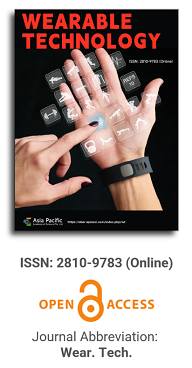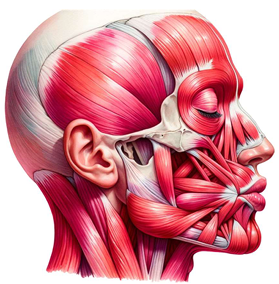

This paper delves deeply into the innovative realm of integrating human emotions with wearable technology. The primary focus is on the conceptualization and development of a kiss transfer device that harnesses the power of wearable technology to bridge the physical gap in human-human interactions. By investigating the intricate nuances of the human-human kissing process, the research seeks to replicate this intimate gesture through a technological medium. The paper not only elaborates on the anatomy, evolution, and hormonal dynamics of kissing but also underscores the transformative potential of wearable technology in capturing and transmitting these intimate moments. This exploration opens up new horizons for long-distance relationships, offering a tangible touchpoint that goes beyond traditional communication methods. Through this pioneering work, the research positions wearable technology as not just a tool for communication but as an extension of our human emotions and expressions.

Flexible sensors in smart textiles and their applications
Vol 2, Issue 2, 2021
Download PDF
Abstract
Sensors are the core part of intelligent smart textiles, and flexible sensors play an important role in wearable smart textiles because of their softness, bend ability and stretch ability, and excellent electrical properties. Based on the working principle of sensors, the research progress of flexible sensors for smart textiles in recent years is reviewed, and the sensing mechanism, sensing materials and application status of different sensors are introduced respectively; the main research directions of flexible sensors for smart textiles are summarized: physiological parameter detection, pressure detection and motion detection, and the applications of the three research directions are reviewed. On this basis, the problems of intelligent flexible sensors and their development prospects are pointed out.
Keywords
References
- Yang D. Intelligent materials and intelligent systems. Tianjin: Tianjin University Press; 2000. p. 24–37.
- Li X. An overview of intelligent fiber and intelligent textiles (in Chinese). Cotton Textile Technology 2009; 37(6): 62–64.
- Shi M, Xiao H. The present state and perspectives of the smart textiles (in Chinese). Hi-Tech Fiber and Application 2010; 35(4): 5–8.
- Cochrane C, Koncar V, Lewandowski M, et al. Design and development of a flexible strain sensor for textile structures based on a conductive polymer composite. Sensors 2007; 7(4): 473–492.
- Qian X, Su M, Li F, et al. Research progress in flexible wearable electronic sensors (in Chinese). Acta Chimica Sinica 2016; 74(7): 565–575.
- Yin J, Wang Y, Ju G. Introduction to functional materials. Harbin: Harbin Institute of Technology Press; 1999. p. 256–258.
- Liu M, Zhuang Q. The application and development foreground of smart flexible sensor (in Chinese). Progress in Textile Science and Technology 2009; (1): 38–40, 42.
- Ma Y, Liu Q, Liu W. Research progress of flexible sensor for smart textiles (in Chinese). Transducer and Microsystem Technologies 2015; 34(4): 1–3, 7.
- Atalay O, Kennon WR, Husain MD. Textile-based weft knitted strain sensors: Effect of fabric parameters onsensor properties. Sensors 2013; 13(8): 11114–11127.
- Li L, Ding Y. Design and analysis of woven structure-based flexible strain sensor (in Chinese). Chinese Journal of Sensors and Actuators 2008; 21(7): 1132–1136.
- Wilson JS. Sensor technology handbook. Holland: Butter-Worth-Heinemann; 2005.
- Pang W, Liu T, Li Y, et al. Review on fabric-based sensor (in Chinese). Technical Textiles 2012; 30(6): 1–7.
- Fan Q, Zhang X, Qin Z. Preparation of polyaniline/polyurethane fibers and their piezoresistive property. Journal of Macromolecular Science, Part B(Physics) 2012; 51(4): 736–746.
- Wang Q, Wu B, Song Y, et al. Design of a signal conditioner circuit for the PVDF piezoelectric transducer (in Chinese). Chinese Journal of Scientific Instrument 2006; 27(Sup.2): 1653–1655.
- Wu S, Liu W, Liu X. Research progress of flexible fabric strain sensor (in Chinese). Transducer and Microsystem Technologies 2017; 36(12): 1–3.
- Liu H, Chen T, Zhao L, et al. Research progress on the fabric with ppy-coating (in Chinese). China Textile Leader 2018; (3): 64–67.
- Liu T, Zou F. Structural design and sensing performance of conductive knitted fabrics of carbon coated fibers (in Chinese). Journal of Textile Research 2014; 35(9): 31–35, 46.
- Li Y, Chen T, Yang X. Conductive fibers for textile and its applications (in Chinese). Technical Textiles 2010; 28(4): 32–35.
- Rothmaier M, Luong MP, Clemens F. Textile pressure sensor made of flexible plastic optical fibers. Sensors 2008; 8(7): 4318–4329.
- Guo X, Yang K, Zhang C. Research progress of flexible textile sensors (in Chinese). Wool Textile Journal 2018; 46(8): 86–91.
- Gao Z. Fabrication of distinguishable target gas based on flexible gas sensor wearable mask [PhD thesis]. Changchun: Jilin University; 2017.
- DeJonckheere J, Narbonnean F, Kinet D, et al (editors). Optical fiber sensors embedded into technical textile for a continuous monitoring of patients under magnetic resonance imaging. 30th Annual International Conference of the IEEE Engineering in Medicine and Biology Society; Vancouver BC: IEEE; 5266–5269.
- Guo Q. Development of smart seamless garments integrating different conductive materials with knitted flexible sensors [PhD thesis]. Shanghai: Donghua University; 2017.
- Huang C, Tang C, Lee M, et al. Parametric design of yarn-based piezoresistive sensors for smart textiles. Sensor and Actuators A (Physical) 2008; 148(1): 10–15.
- Kang T, Merritt C, Karaguzel B, et al (editors). Sensors on textile substrates for home-based healthcare monitoring. 1st Distributed Diagnosis and Home Healthcare (D2H2) Conference; 2006; Virgina: IEEE; p. 5–7.
- Tian X, Yang K, Zhang C. Design of pulse sensing fabric based on fiber bragg grating (in Chinese). Journal of Textile Research 2016; 37(10): 38–41.
- Yang X, Chen Z, Elvin CSM, et al. Textile fiber optic micro bend sensor used for heartbeat and respiration monitoring. Sensors Journal IEEE 2015; 15(2): 757–761.
- Ozdemir, HO, Kilinc S. Smart woven fabrics with portable and wearable vibrating electronics. Autex Research Journal 2015; 15(2): 99–103.
- Peng X, Yang X, Hu J. Study on respiration monitoring piezo-resistive sensors based on embroidery (in Chinese). Journal of Donghua University (Natural Science Edition) 2014; 40(6): 712–717, 727.
- Cai Q, Chen W, Wang J. Effect of washing and heat setting on electric conduction of flexible sensors (in Chinese). Advanced Textile Technology 2017; 25(1): 23–27, 55.
- Wang J. Electrical-mechanical properties of conductive knitted flexible sensors and pressure testing of underwear [PhD thesis]. Shanghai: Donghua University; 2013.
- Wang Y. Research on the pressure performance of elastic knitted fabrics and the design of testing system and development [PhD thesis]. Shanghai: Donghua University; 2010.
- Yi W, Zheng R, Gu Y. The piezoresistive performance of conductive knitted fabric under small pressure (in Chinese). Knitting Industries 2014; (9): 12–14.
- Pang X, Fang Y, Li X. Pressure testing of compression stockings based on flexible pressure sensor (in Chinese). Journal of Zhejiang Institute of Science Technology University (Natural Sciences) 2017; (6): 759–764.
- Tang Q, Xiao J, Wei Q. Establishment and evaluation of dynamic pressure measurement system for sports wears (in Chinese). Journal of Textile Research 2009; 30(9): 123–126.
- Gao M, Zhang Y, Hong C, et al. Application of flexible sensors in the plantar pressure measurement system (in Chinese). Journal of Clothing Research 2018; 3(4): 301–307.
- Jin M, Ding X, Gan Y, et al. A sensing insole for measuring plantar pressure distribution (in Chinese). Journal of Textile Research 2010; 31(9): 114–117.
- Lee TH, Kim ES, Kim TH, et al. Simple pressure sensor for a vehicle seat using a woven polymer optical-sheet. Journal of the Korean Physical Society 2015; 67(11): 1947–1951.
- Jin X. Research and application of intelligent clothes rack based on multi-objective collaborative optimization algorithm application [PhD thesis]. Shanghai: Donghua University; 2017.
- Tian H, Liu P, Guo X, et al. Flexible pressure/temperature composite perceptual system based on conductive rubber (in Chinese). Transducer and Microsystem Technologies 2015; (10): 100–103.
- Xie J. Bi-directional extension electro-mechanical properties of knitted fabric sensors and limb movement monitoring [PhD thesis]. Shanghai: Donghua University; 2015.
- Helemer RJN, Farrow D, Ball K. A pilot evaluation of an electronic textile for lower limb monitoring and interactive biofeedback. Procedia Engineering 2011; 13(1): 513–518.
- Tognetti A, Lorussi F, Mura GD, et al. New generation of wearable goniometers for motion capture systems. Journal of Neuro Engineering and Rehabilitation 2014; 11(1): 56–73.
- Zhang X, Li G, Hu J, et al. Mechanic-electronical property characterization of ppy-coated conductive woven fabric for human upper limb motion monitoring (in Chinese). Chinese Journal of Biomedical Engineering 2015; 34(6): 670–676.
- Shi X, Xiong Q, Lei L. Study on human motion recognition method based on pressure sensor (in Chinese). Chinese Journal of Scientific Instrument 2010; 31(6): 1429–1434.
- Yang H, Dong W. Design of elbow motion detection system on piezoelectric thin film sensor (in Chinese). Electronic Engineering and Product World 2017; (1): 41–43.
- Su M, Li F, Chen S, et al. Nanoparticle based curve arrays for multi-recognition flexible electronics. Advanced Materials 2016; 28(7): 1369–1374.
Supporting Agencies
Copyright (c) 2021 Wen Wen, Fang Fang

This work is licensed under a Creative Commons Attribution 4.0 International License.

Prof. Zhen Cao
College of Information Science & Electronic Engineering, Zhejiang University
China, China
Processing Speed
-
-
-
- <5 days from submission to initial review decision;
- 62% acceptance rate
-
-
Asia Pacific Academy of Science Pte. Ltd. (APACSCI) specializes in international journal publishing. APACSCI adopts the open access publishing model and provides an important communication bridge for academic groups whose interest fields include engineering, technology, medicine, computer, mathematics, agriculture and forestry, and environment.





